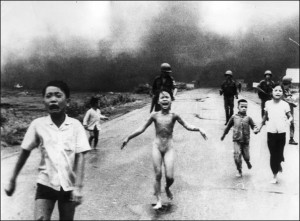This week in class, we read an excerpt from one of Philip Gourevitch’s gripping book We Wish to Inform You That Tomorrow We Will Be Killed With Our Families about the genocide in Rwanda. His testimony of visiting the Nyarubuye Church after the massacre initiated a bigger discussion of what is ethically acceptable when it comes to using actual human remains to bear testimony of atrocities to commemorate events in the past, and also to assure that nobody ever forgets or questions the authenticity of this history. Andrea shared with us her family’s images from a visit to Auschwitz, a site that remains not only a ruin of a painful past, but also provides actual evidence against Holocaust deniers today. It is hard to argue against such tangible facts on the ground. Then a friend of mine, Petter Linde, who also happens to be an archaeologist, sent me an interesting link to an article by BBC News, that reveals a similar discussion about the ethics of photographing and displaying images of the dead from World War 1, entitled Fallen Soldiers: Is it right to take images of bodies?

Is it acceptable to show images like this from WW1, or is it ethically so problematic that the benefits of bearing witness of these horrific events do not compensate for the humiliation and lack of sensitivity and respect for the dead?
Documenting the dead – to create a record, to support testimonies of atrocities, to communicate what most of us are unable to put into words – has long been business as usual for journalists. But we see that today this is becoming increasingly questioned by both the public and by authorities. I understand the visceral reaction to photos of dead people, and I feel sympathy for those who feel that this is in some way undignified or at least questionable. But at the same time we must then also ask ourselves where to draw the line? Is it not equally, if not more problematic, to publish images of living people in conflicts – those who may still be suffering, or whose lives may be at risk because of the exposure. Is it not more objectionable to capture the images of starving children or wounded soldiers, than of dead ones? Of course, this immediately gets very complicated and probably we must resort to an uncommitted “it depends”. And yet, without testimonies like this, would the world community care, even less take action?

The image of the naked Phan Thi Kim Phuc in 1972 raised awareness among the American public about the reality on the ground in Vietnam and the effects of the use of napalm bombing for thousands of civilians.
Without images like that of Phan Thi Kim Phuc the American public may have felt differently about the Vietnam war.
But the question remains: how far should we go to use the bodies of the dead to tell our stories? Do their voices to some extent still speak through the materiality of their bodies, or, are we simply exploiting the raw effect these gruesome images have to make our own points and further our own agendas?
Liv Nilsson Stutz
